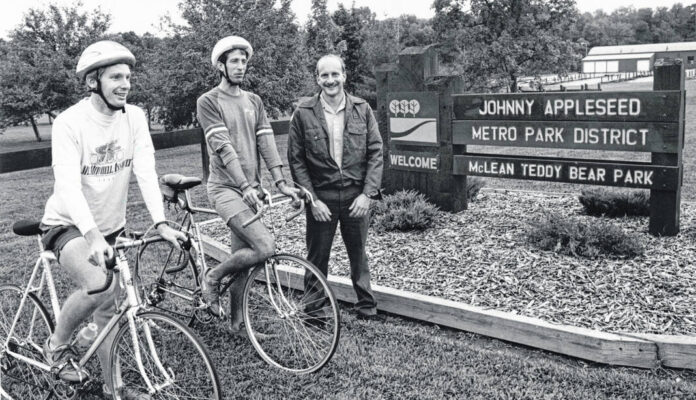LIMA — The people of Allen County just needed some space to get out and enjoy nature.
That was the idea behind what would become the Johnny Appleseed Metropolitan Park District. Over the 50 years that followed the formation of this park district, that idea has grown, some might say organically, from the early days of Heritage Park and McLean Teddy Bear Park to a district today that features such amenities as archery, swimming, bike and walking paths, a bird sanctuary, a historical farm, an environmental education center and a veterans monument.
After a 1969 study by the Ohio Department of Natural Resources examining recreation and open spaces in Ohio caught the attention of the Allen Soil Conservation District, the study was brought to the attention of the county board of commissioners, who appointed a park advisory board the following year to explore this issue. A three-month feasibility study two years later finally culminated in an application to Allen County Probate Court for the creation of the district that would “include all of Allen County with the exception of Delphos and Beaverdam,” The Lima News wrote in a June 28, 1972 article.
That same article outlined the arguments made to Probate Court Judge David O. Steiner about the benefits the county would enjoy thanks to this initiative.
“Charles Williams, a soil conservationist with the U.S. Department of Agriculture, and City Planning Director Richard Schroeder both testified that the county is suffering from an acute lack of natural recreational areas,” the article reads. “Most of the recreational land in the county is tied up in six golf courses, leaving only about 300 acres of actual parkland, they said.”
With Judge Steiner approving the district’s creation two days later, the new district, led by commissioner Ann Lauer, gained its first foothold in the county, establishing McLean Teddy Bear Park on North Dixie Highway that same year, thanks to a no-cost, 99-year lease with the county commissioners. The name came from the Lima Area Jaycees, honoring a man known for providing teddy bears to children in area hospitals to help provide comfort in their difficult times. The initial 20 acres for that park quickly grew to 42.5 acres that first year, increasing to 56 acres in 1980, thanks to a 10-acre donation by Henry Koch and the purchase of 3.5 additional acres of land by the district.
According to the park district’s website, the district’s footprint grew tremendously in 1973 with the acquisition of 162 acres of land from the Lima Army Modification Center near Reed Road via a deed from the federal government, land that became Heritage Park. That area was cut in half five years later when some of the land was returned to the U.S. Army for expansion of its facilities.
Despite a failed levy attempt in 1976, other areas of expansion soon followed for the district, the creation of park rangers including 45 acres of land at the Allen County Farm Park acquired by long-term lease from the county in 1977. A substantial addition, however, came later that same year, with 182 acres of land near Spencerville acquired thanks to a substantial bequest.
“The park district will pay George and Germaine Strayer of rural Spencerville $230,000 for the land,” The Lima News wrote in a Nov. 13, 1977 article. “Money to purchase the land was willed to the park district in July 1976 in the estate of the Late Florence Kendrick specifically for acquisition of parkland.”
District executive director Jency Brown lauded the purchase of the land that would soon take on the name of the benefactor that made the purchase possible, noting that it was the “biggest single tract of woods in the county,” he said. Brown was also excited for people to enjoy what he saw as the more scenic Auglaize River as compared with the Ottawa River at the time.
“To be frank, the Ottawa River running through Lima isn’t much to look at,” Brown said in the article. “It’s full of pollution and it’s got trash floating in it.”
After purchasing 25 additional acres on the site in 1985 for shelter houses and restrooms, as well as just under 22 acres of conservation easement land purchased a year later, Kendrick Woods Metro Park was officially opened in 1987.
Establishing levies to help fund the district continued to be a source of concern for the district in that first decade, with attempts at levies failing in 1978, 1979 and 1982, the year that the Allen County Farm Park opened off state Route 81. Finally, in 1983, a one-third mill levy was approved.
Today’s district map features 20 points of interest, including the district’s most recent addition, Haver Ridge Metro Park, featuring 61 acres of land southeast of Westminster purchased by the district in 2019. Even after 50 years, the district is still continuing to expand its footprint in the area, recently accepting a donation of 50 acres of land in Amanda Township to be used as a nature conservation area.
The district will commemorate its namesake with its Apple Festival, running from noon to 6 p.m. Saturday and Sunday at the Lauer Historical Farm, 800 Roush Road. For more information on the festival, go to https://bit.ly/3xmNyB0.
SOURCE
This feature is a cooperative effort between the newspaper and the Allen County Museum and Historical Society.
LEARN MORE
See past Reminisce stories at limaohio.com/tag/reminisce
Reach Craig Kelly at 567-242-0391 or on Twitter @cmkelly419.







